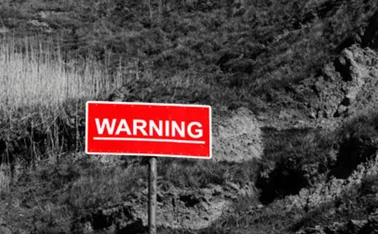
Analysis: Are cavity wall insulation claims the new PPI?

Insurers are seeing a spike in people claiming improper installation of cavity wall insulation. Is this the new money spinner for CMCs?
Claimant solicitors have got to eat. As the deadline for payment protection insurance claims draws closer, many claims management companies have been casting nervous glances around for alternative revenue streams.
First there was a travel claims epidemic, which has since died down. Now, insurers are seeing a huge spike in people claiming their homes have been damaged by damp from the improper installation of cavity wall insulation.
In August last year, Axa had 100 claims for improper cavity wall installation. By the end of quarter one this year, that number had risen to 1800 – a 1700% increase.
Similarly, QBE has seen CWI claims grow “exponentially” over the last three years, with volumes rising by 700% in this year alone.
What are CWI claims?
The majority of homes built before the 1970s didn’t have any form of insulation. They were built with vast cavities in the walls.
In the 1990s, there was a greater awareness of energy efficiency. Operating on grants from energy companies, there was accordingly a boom industry for the retrofit of CWI in homes.
But where systems were installed poorly or were never suitable for the property, some homes suffered damp, and legitimate claims followed.
Those claims were generally against the public liability insurance of the installer. “We have always had these claims, but they have been at low levels,” said Andy Williams, technical strategy manager at Axa.
“That changed when claimant solicitors started taking on these claims. They are looking for new avenues, like they did for travel sickness. This is an example of what might be the next big thing.”
How much of an issue is it?
The scale of the problem is difficult to quantify. IRT Surveys released a report in 2015 that found cavity issues existed in one in two of 250,000 surveyed properties.
With six million homes given guarantees by the Cavity Insurance Guarantee Agency, it has been suggested the potential claims pot is as high as three million.
That finding is strongly disputed by Ciga itself, which claims the IRT research was based on a “drive by” thermal imaging survey that did not account for time of year, or other structural issues.
“With a thermal imaging report you can make things look good, you can make them look bad,” said Nigel Donohue, CEO of Ciga.
Instead, Ciga itself sees only four claims for every 1000 guarantees, or a claims pot of 24,000.
“This is not an epidemic,” said Donohue. “It’s nowhere near the order of three million.”
However, IRT stood by its research. CEO Stewart Little said: “Our surveys are done on foot by trained thermographers and analysed by algorithms. Mathematics dictates the result with no vested interest in the outcome.
“In fact we surveyed 1700 homes in Yorkshire 10 months ago and went on to boroscope them, extract and refill them. Everyone had failed.
“There are about 3.5 million homes with failing insulation out there. From 10.6 million post-1950’s cavity homes. One-third good, one-third empty and one-third failed badly. Even if I’m 50% wrong, that’s a huge number and miles away from Ciga’s 99.6% perfect claim. No industry is that good.”
Ofgem lists problem rates (but not necessarily failure rate) among cavity wall insulation owners at 7%, or 420,000 of Ciga’s six million guaranteed homes.
Regardless of who is right, CMCs have jumped on what they perceive to be a ripe market.
“It’s a perfect storm,” said Joseph Noel, complex liability regional director at Sedgwick. “We have the restriction of other revenue streams for CMCs through the PPI deadline and the whiplash reform, and they are looking to new areas.”
Jason Potter, head of investigations at the Insurance Fraud Bureau, said it was a natural progression. “If you’re an unscrupulous company, whether you’re a CMC or whatever, you’re going to look for a gap in the market, and exploit where the weak points are in order for maximum financial gain,” he said.
“It’s a natural progression onto another area where they can see an opportunity.”
In numbers
1700%
The rise in CWI claims seen by Axa from August last year to the end of Q1 this year
700%
The rise in CWI claims seen by QBE in this year alone
200%
The rise in CWI claims seen by Sedgwick in the past 18 months
3m
The potential CWI claims pot, extrapolating from a survey by IRT
24,000
The potential CWI claims pot, extrapolating from Ciga data
Lead generation
So how do CMCs operate in this field? One way of generating leads is by door knocking. In certain instances, Axa has noticed a spread of claims across a single geographic footprint, which suggested that CMCs are knocking on doors to ask people if they have experienced damp. That mirrors how installers originally operated in certain regions.
The other means of generating leads, and far more common, is by involving Ciga.
Ciga is an independent body that provides guarantees for up to 25 years for registered installers of cavity insulation. If customers experience failure in the insulation, the body carries out its own inspection and – where appropriate – provides remediation to the property.
It doesn’t provide compensation for soft furnishings or other aspects of the property damaged by damp from faulty installation. For that reason, most CMCs will advise customers to pursue claims against the PL cover of the original installer for a lump sum compensation pay out, rather than seeking to get the insulation removed or replaced through Ciga.
“Claims solicitors absolutely have no interest in Ciga,” said Donohue. “Their interest in us is in trying to extract who the installer was, and if they had PL cover, who the insurer was at the time.”
In order to do that, CMCs often attempt to get a duplicate copy of the guarantee, which lists the name of the installer as well as the PL insurer. The latter point is particularly salient when an installer has gone out of business in the 25 years following the work being done.
Donohue said: “If you’re looking for details of the installer’s PL cover, we don’t provide that. So the way they try to get it is by getting a duplicate copy of the guarantee.
“We’ve had claims lead generators calling us fraudulently pretending to be the home owners, we’ve caught a few out. I had three ‘customers’ on the phone at the same time with the same name, two of them lead generators and one of them the real customer.”
He added: “In order to get around that, Ciga has changed its policy to send the copy of the guarantee directly to the homeowner, rather than the solicitor who requests it.
“After we’ve sent it, sometimes we had homeowners call us directly and say they didn’t request it,” he added.
Inflation
Donohue said Ciga records all its calls. He claims to have recordings of solicitors coaching clients during the menu section of the call on how to inflate claims.
“We are finding evidence of fraudulent reports with significant orders of magnitudes of claim,” he said. “When we send our own inspectors out there to do forensics, we tend to find the problems they report are nowhere near as significant. In some cases there simply is no problem at all.”
In other cases, he said he has seen three or four inspection reports that use the same images.
Noel said he had obtained course material used to train staff at CMCs on how to bolster and defend a claim.
“If claimant law firms can ensure that damages are above £10,000, then their hourly rate costs follow,” he said. “It’s a lucrative area.”
In addition to that, properties are often inadequately inspected. That has seen many claims die quickly because insurers are willing to robustly defend their corners.
“We have picked holes in everything in the letters of claim, suggesting that they aren’t compliant, they don’t contain enough detail,” said Williams.
“A lot of the claims have died a death because of that. That leads me to believe that either the claimant lawyers don’t have enough technical expertise, or the claims don’t have enough substantiation to them anyway because of that lack of validation at the outset.”
According to Donohue, the techniques used by CMCs are designed to strong arm insurers into paying.
“The claims management model is not to get it into court,” he said. “Unless they’ve got a loan agreement or after the event insurance, they’re not going to get fed. Their aim is to get insurers to blink first and pay, or for installers to suggest a settlement.”
Regulation
The Financial Conduct Authority will primarily regulate CMCs in the personal injury space. In addition it will regulate their activity in tenancy disputes, mis-selling of a financial product, benefits, criminal injury and employment.
CWI claims and travel sickness claims will not be regulated. Donohue said Ciga has been lobbying the government to include the area into the draft regulation, to no avail.
He said: “If the FCA is going to do what it said it is going to do, I admire it, it has grasped the nettle. It’s going to be a well-regulated environment that is going to give genuine claimants proper redress. The danger is that companies will move away from the FCA and into the unregulated space.
“In my opinion every claims management lead activity should be regulated. There shouldn’t be the haves and have nots.”
That was something that Williams agreed with. “This kind of activity we are seeing – knocking on doors to generate claims and a lack of validation of claims – that should be regulated in principle,” he said. “It’s only right that we expect claimant lawyers to present legitimate claims.”
The issue of CWI claims has been raised with the Solicitor’s Regulation Authority, where there is a growing understanding of the emerging problem.
In addition, the IFB has been made aware of the issue. Earlier this year it issued alerts against a number of lawyers over the issue.
Potter said the IFB’s understanding of the problem was still in its infancy.
“We are involved in negotiation between Ciga and the regulators to see what we can do in this space,” he said.
“It’s very early days in terms of getting into the granular details of these scams, if indeed they are scams, and establishing what role we can play. Ciga has offered us intelligence which we are progressing with, we are keen to work all industry bodies involved to drill down into what’s really happening and who the main players are, and how we can stem the activity, if at all.
“We are currently talking to the SRA. We could potential broaden that out to the FCA or the Ministry of Justice. It could eventually lead down the road to law enforcement. It’s about bringing together and using all those disruption agencies.”
The joined-up approach is one that is supported by Jonathan Radford, special investigation unit claims manager at QBE.
“This is becoming an increasing fraud threat to tackle in the commercial insurance space and one that we are working hard to address at an industry-wide level with a collaborative approach,” he said.
Only users who have a paid subscription or are part of a corporate subscription are able to print or copy content.
To access these options, along with all other subscription benefits, please contact info@postonline.co.uk or view our subscription options here: http://subscriptions.postonline.co.uk/subscribe
You are currently unable to print this content. Please contact info@postonline.co.uk to find out more.
You are currently unable to copy this content. Please contact info@postonline.co.uk to find out more.
Copyright Infopro Digital Limited. All rights reserved.
As outlined in our terms and conditions, https://www.infopro-digital.com/terms-and-conditions/subscriptions/ (point 2.4), printing is limited to a single copy.
If you would like to purchase additional rights please email info@postonline.co.uk
Copyright Infopro Digital Limited. All rights reserved.
You may share this content using our article tools. As outlined in our terms and conditions, https://www.infopro-digital.com/terms-and-conditions/subscriptions/ (clause 2.4), an Authorised User may only make one copy of the materials for their own personal use. You must also comply with the restrictions in clause 2.5.
If you would like to purchase additional rights please email info@postonline.co.uk








